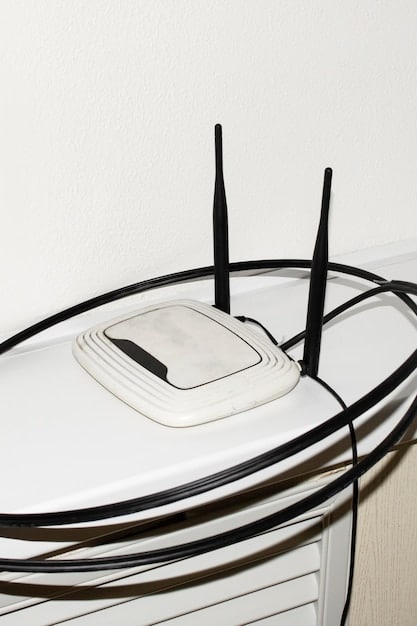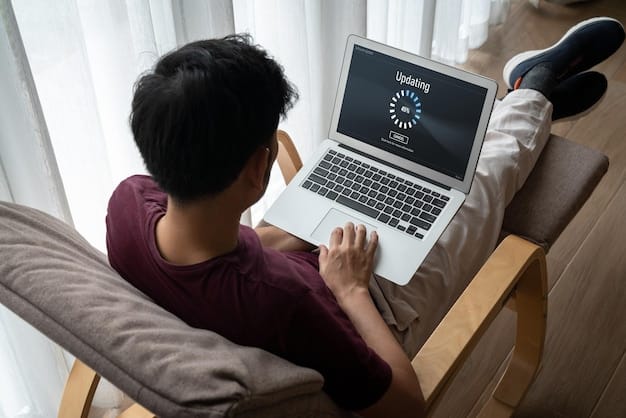Streaming Quality Issues in 2025: Troubleshooting Guide

Streaming quality concerns such as buffering and lag in 2025 can be addressed by checking internet speed, optimizing network configurations, updating devices and apps, managing background processes, and adjusting streaming settings to improve viewing experience.
Experiencing frustrating buffering or lag while streaming your favorite shows in 2025? You’re not alone. Let’s dive into troubleshooting **streaming quality concerns** and provide you with practical tips to enjoy seamless entertainment.
Understanding Streaming Quality Challenges in 2025
As streaming technology evolves, so do the challenges that impact viewing quality. Factors ranging from network congestion to outdated hardware can contribute to disruptions. This section explores common culprits behind poor streaming performance and sets the stage for effective troubleshooting.
The Impact of Network Congestion
Network congestion remains a significant hurdle for smooth streaming. During peak hours, internet service providers (ISPs) may struggle to handle the increased demand, resulting in slower speeds and buffering issues.
Outdated Hardware and Software
Old devices and outdated apps can lack the necessary processing power and codecs for modern streaming formats. Keeping your hardware and software up to date is crucial for optimal performance.

Here are a few more challenges that can impact streaming quality:
- Distance from Router: The further your device is from the router, the weaker the Wi-Fi signal, causing lag.
- Bandwidth Limitations: Some internet plans have data caps or bandwidth throttling, which can reduce streaming quality once you’ve used a certain amount of data.
- Background Apps: Other applications running on your device or network can consume bandwidth, affecting streaming.
Understanding these challenges is the first step toward effectively resolving streaming quality concerns. Next, we’ll explore specific troubleshooting tips to address these issues.
Optimizing Your Home Network for Streaming
Your home network is the backbone of your streaming experience. Optimizing it can significantly improve streaming quality. This section provides actionable steps to enhance your network configuration.
Checking Your Internet Speed
The first step in optimizing your network is to ensure you have sufficient bandwidth for streaming. Run a speed test using online tools to verify if your internet speed meets the recommended requirements for your streaming services.
Upgrading Your Router
An outdated router can be a major bottleneck in your network. Consider upgrading to a newer model that supports the latest Wi-Fi standards (e.g., Wi-Fi 6) for better performance and range.

Here are techniques to optimize your network:
- Position Your Router Strategically: Place your router in a central, open location, away from obstructions like walls and metal objects.
- Use an Ethernet Cable: For devices that support it, a wired Ethernet connection provides a more stable and faster connection than Wi-Fi.
- Prioritize Streaming Traffic with QoS: Enable Quality of Service (QoS) settings on your router to prioritize streaming traffic over other network activities.
Effective network optimization lays the foundation for smooth streaming. By ensuring your network is up to par, you’re setting the stage for an uninterrupted viewing experience.
Troubleshooting Device-Specific Streaming Issues
Sometimes, the problem lies within the streaming device itself. Different devices have their own quirks and potential issues. This section offers troubleshooting tips specific to common streaming devices.
Smart TVs
Smart TVs can suffer from performance degradation over time due to limited processing power and storage. Clearing the cache, closing unnecessary apps, and performing regular software updates can help improve performance.
Streaming Sticks (e.g., Roku, Chromecast, Fire Stick)
Streaming sticks are compact and convenient, but they can also be prone to overheating and connectivity issues. Ensure your streaming stick is properly ventilated and connected to a stable power source.
Gaming Consoles (e.g., PlayStation, Xbox)
Gaming consoles offer robust streaming capabilities, but they can be affected by network settings and game downloads. Optimize your console’s network settings and avoid downloading games while streaming.
Consider these points when troubleshooting device-specific streaming issues:
- Restart Your Device: A simple restart can often resolve temporary glitches and improve performance.
- Update Firmware: Ensure your device’s firmware is up to date to benefit from the latest performance improvements and bug fixes.
- Factory Reset: If other troubleshooting steps fail, consider performing a factory reset to restore your device to its original settings.
Addressing device-specific issues can significantly enhance your streaming experience. By targeting the unique challenges of each device, you can optimize performance and enjoy smoother playback.
Managing Bandwidth and Data Usage
Bandwidth limitations and data caps can severely impact streaming quality. Managing your bandwidth effectively is crucial to avoid interruptions. This section provides strategies to monitor and control your data usage.
Monitoring Data Usage
Keep track of your data usage to avoid exceeding your monthly data cap. Most ISPs provide online tools or apps to monitor your data consumption in real-time.
Adjusting Streaming Quality Settings
Lowering the streaming quality can significantly reduce data usage. Many streaming services offer options to adjust video resolution, allowing you to balance image quality with data consumption.
Closing Unnecessary Apps
Background apps can consume bandwidth even when you’re not actively using them. Close any unnecessary apps to free up bandwidth for streaming.
Consider these data management techniques:
- Download Content in Advance: If possible, download content during off-peak hours to avoid using bandwidth while streaming.
- Use Data-Saving Mode: Some streaming services offer a data-saving mode that automatically reduces video quality to minimize data usage.
- Manage Connected Devices: Limit the number of devices connected to your network simultaneously to prevent bandwidth overload.
Effective managing bandwidth and data usage ensures you can stream without interruptions. By monitoring and adjusting your data consumption, you can maximize your viewing experience without exceeding your data limits.
Advanced Troubleshooting Techniques
When basic troubleshooting steps are not enough, advanced techniques may be necessary to resolve persistent streaming issues. This section delves into more complex solutions that can help improve your streaming quality.
Checking for Interference
Wireless interference from other devices or appliances can disrupt your Wi-Fi signal. Identify and eliminate potential sources of interference, such as microwaves, Bluetooth devices, and cordless phones.
Using a Wi-Fi Analyzer
A Wi-Fi analyzer app can help you identify the least congested Wi-Fi channel in your area. Switching to a less crowded channel can improve your Wi-Fi performance.
Contacting Your ISP
If you suspect that your ISP is throttling your bandwidth or experiencing network issues, contact them to inquire about potential problems and solutions.
Consider these advanced strategies:
- Using a VPN: A Virtual Private Network (VPN) can sometimes improve streaming quality by routing your traffic through a different server, bypassing potential network congestion.
- Configuring DNS Settings: Changing your DNS settings can improve your internet speed and stability. Consider using a public DNS server like Google DNS or Cloudflare DNS.
- Resetting Your Modem and Router: Performing a hard reset of your modem and router can resolve stubborn connectivity problems.
Advanced troubleshooting techniques offer solutions for complex streaming issues. By addressing underlying network and configuration problems, you can often achieve significant improvements in streaming quality.
Future-Proofing Your Streaming Setup for 2025 and Beyond
As streaming technology continues to evolve, future-proofing your setup is essential to maintain optimal performance. This section provides insights into emerging technologies and best practices to ensure your streaming experience remains smooth and enjoyable for years to come.
Embracing Wi-Fi 6E and Beyond
Wi-Fi 6E offers faster speeds, lower latency, and increased capacity compared to previous Wi-Fi standards. Upgrading to a Wi-Fi 6E-compatible router and devices can future-proof your network.
Adopting AV1 Codec
The AV1 codec is a next-generation video compression standard that offers better compression efficiency than older codecs like H.264 and HEVC. Ensure your devices and streaming services support AV1 for improved video quality at lower bandwidth requirements.
Subscribing to Higher Bandwidth Plans
As streaming resolutions increase (e.g., 8K), higher bandwidth plans will become increasingly necessary. Evaluate your internet needs and consider upgrading to a plan that meets the demands of modern streaming.
Consider these strategies to your streaming setup:
- Investing in a Mesh Wi-Fi System: Mesh Wi-Fi systems provide broader coverage and more stable connections throughout your home.
- Optimizing Device Placement: Strategically place your streaming devices to minimize interference and maximize signal strength.
- Staying Informed About Technological Advancements: Keep abreast of the latest developments in streaming technology to identify opportunities to enhance your setup.
Future-proofing your streaming setup ensures you are well-prepared for the evolving landscape of streaming technology. By embracing the latest standards and best practices, you can enjoy a seamless and immersive viewing experience for years to come.
| Key Point | Brief Description |
|---|---|
| 💡 Network Optimization | Enhance Wi-Fi, ensure strong signal, upgrade router. |
| 📺 Device Troubleshooting | Update firmware, clear cache, restart devices. |
| 📊 Data Management | Monitor usage, adjust streaming quality to minimize bandwidth. |
| 🚀 Future-Proofing | Embrace Wi-Fi 6E, AV1 codec for better streaming. |
Frequently Asked Questions (FAQ)
▼
Slow streaming is often due to network congestion, insufficient bandwidth, or outdated device firmware. Ensure your internet speed meets streaming requirements and update your devices.
▼
Improve Wi-Fi by positioning your router centrally, away from obstructions. Use a Wi-Fi analyzer to find the least congested channel and consider a mesh Wi-Fi system for broader coverage.
▼
Clearing the cache removes temporary data stored by apps, which can improve performance and free up storage space on your streaming devices.
▼
Yes, 5 GHz Wi-Fi generally offers faster speeds and less interference than 2.4 GHz, making it better for streaming high-quality video content.
▼
AV1 is a next-generation video compression standard that offers better compression efficiency, allowing for higher video quality at lower bandwidth requirements, future-proofing your setup.
Conclusion
By following these troubleshooting tips and optimizing your streaming setup, you can minimize buffering and lag, ensuring a seamless and enjoyable viewing experience in 2025 and beyond. From network optimization to device-specific solutions and future-proofing techniques, a well-rounded approach will help you make the most of your streaming services.





